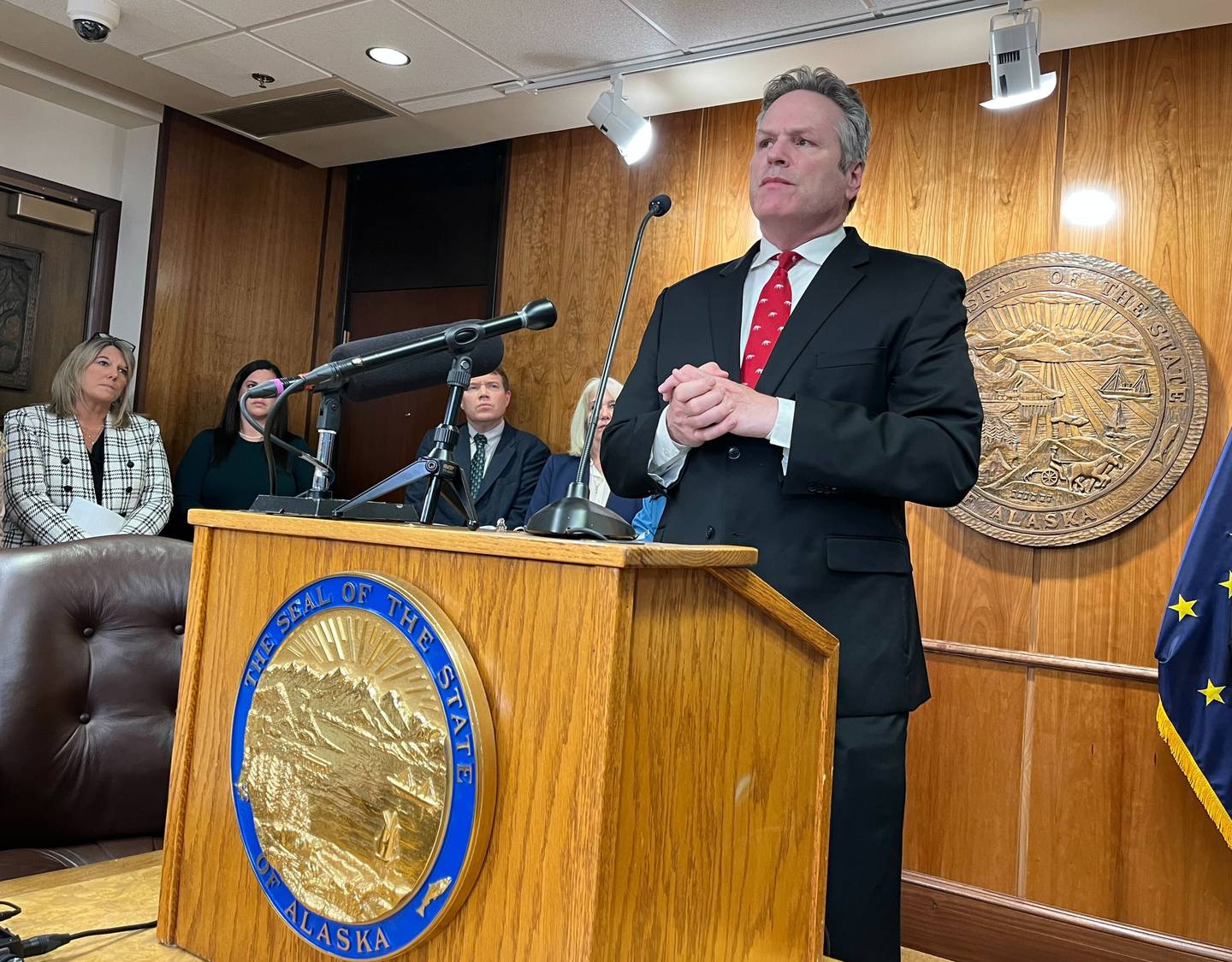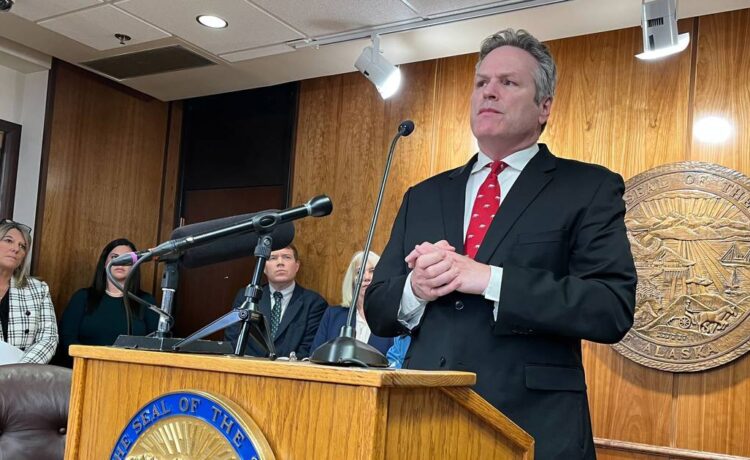
Alaska Gov. Mike Dunleavy on Thursday unveiled his “status quo” budget proposal for the next fiscal year. While the budget bill is just a starting point that will be amended by the Alaska Legislature before it’s finalized in mid-2024, it does contain hundreds of new policy proposals for lawmakers to consider. Here are just some of the proposed changes.
Solving a payroll crisis
The Department of Administration requested over $2 million to “continue the modernization and automation process for statewide timesheet auditing” and other tasks related to payroll, after a union representing thousands of state employees filed a grievance earlier this year over repeated paycheck problems.
Staffing problems at the state payroll division, which processes paychecks for the state’s 18,000 employees, caused many workers this year to be paid late or incorrectly, and led the state to sign a $315,000 contract with a private firm to assist with processing payroll requests.
[Dunleavy proposes budget with $1 billion deficit and no new revenue sources]
The payroll division already received $2.2 million in the current year’s budget, which was used for a “digital solution for timesheet auditing only.” The additional funding requested this year “is needed to continue the timesheet automation and electronic storage,” the department said in its request.
The department is also asking for $650,000 for recruitment and retention incentives for payroll employees. And it is formally transferring the payroll staff that handles paychecks for the marine highway system to the Department of Transportation. Payroll processing issues led the ferry system to lose workers earlier this year, but after the transportation department took over, ferry staff said the situation improved.
State funding for replacing the Tustumena ferry
The federal government awarded Alaska $92 million earlier this year to go toward the long-planned replacement of the aging M/V Tustumena. To get those funds, Alaska must provide $23 million in state matching funds.
U.S. Sen. Lisa Murkowski sent a letter to Dunleavy earlier this month urging him to include the matching funds in the state budget. And he did — with a big catch. The match was included using federal toll credits, and it’s unclear whether that’s allowed.
Dunleavy said Thursday that “if we can use funds legally from other sources, it preserves our UGF (Unrestricted General Fund) to be able to use for other things such as education, roads and public safety.” A Dunleavy administration official said Thursday that the administration is “working with the Federal Highway Administration to ensure that it is allowable.”
According to the Alaska transportation department, “toll match credits allow certain toll revenues that were reinvested into maintenance and improvement of a toll facility to be applied towards the state matching funds requirement of certain federal projects.”
Murkowski did not respond to a request for comment on whether Dunleavy’s funding proposal satisfied the appeal in her letter.
Snow removal contracts
When record snow blanketed Anchorage last month, the city lent its equipment to plow state-owned roads under an informal agreement, leading to delays in the clearing of some city streets and alleys. The proposed state budget includes $915,000 for “contracted snow removal” that could be used to pay for similar agreements in the future.
According to the Department of Transportation funding request, the money will “enable the creation of as needed agreements to contract sidewalk, pedestrian facility, and priority 3 and 4 roadway snow removal across the department.”
“Failure to meet these requirements could jeopardize future surface transportation funds and require reimbursement of previously expended funds,” the department said.
New investments in public safety
The Department of Public Safety said it currently has 75 Village Public Safety Officers and no vacant positions — an increase from fewer than 40 officers in 2019. The department wants to spend $3.5 million to hire 10 more VPSOs and raise salaries by 7.4% to $36.29 an hour. But there are still hiring challenges. Budget documents state that there are currently 70 Alaska State Troopers vacancies out of 411 authorized positions, and “numerous” other vacancies at the department. The governor’s plan is to hire a dedicated recruitment manager and pay airfare for trooper applicants from off the road system, which is said to be a barrier to finalize hiring.
The department also wants to hire three dedicated child sexual assault investigators who would be based out of Bethel and focused on the Yukon-Kuskokwim Delta. Commissioner James Cockrell said the department receives three child sexual assault reports per week from the region.
“The volume of sexual assault cases surpasses existing trooper investigator capacity,” budget documents state. The department wants to buy a new $9.5 million patrol boat for Southeast Alaska to help with law enforcement and search and rescue efforts, and to enforce fish and game regulations. The vessel would replace the P/V Enforcer, which was decommissioned last December after years of repairs and the discovery that it was “infested with mold.”
Cockrell said Thursday that a patrol boat would have helped the department better respond to November’s fatal landslide in Wrangell.
[Gov. Dunleavy wants to make an experimental public reading academy permanent]
’Alaska Affordability Act’
In his annual address to the Legislature in January, Dunleavy said that he wanted to make Alaska the most “pro-life state in the nation.” On Thursday, he expanded on that by saying he wanted to make Alaska “the most affordable place — or at least competitive with other states.”
While few new policy details were announced Thursday, Dunleavy said he wanted to introduce what he called “the Alaska Affordability Act” focusing on three areas: housing, energy and child care. One new policy announced Thursday would provide up to $20,000 per recipient to help with mortgage down payments.
Budget documents state that around 1,250 people could receive the aid over the next fiscal year, which would largely come from the Alaska Housing Finance Corp. At a cost of $25 million, the mortgage help would be limited to people who had graduated from college or got a trade certificate in the past five years.
One catch: To receive the full $20,000, recipients would need to live in the home for five years, which is aimed at supporting “the objective of recruiting and retaining Alaskans.”
Toxic firefighting foam
In August, the governor vetoed a bill that would have banned the use of firefighting foams across Alaska containing polyfluoroalkyl substances, known as PFAS, which can be highly toxic if they enter drinking water.
Department of Transportation and Public Facilities Commissioner Ryan Anderson announced Thursday that the administration wanted to spend $7.6 million to convert equipment at state airports to use fluorine-free foams for training and firefighting.
‘Statehood Defense’
The budget proposal builds on a multi-year “statehood defense” effort by the Dunleavy administration, which the governor says is needed to protect Alaska from overreach by the federal government. The state has already allocated millions of dollars to legal fights with the federal government.
This year’s proposal calls for an additional $2 million to be spent on “federal subsistence matters within fish and game; economic and scientific analysis relating to federal rulemaking challenges within environmental conservation, as well as a recent ruling by the US Supreme Court limiting EPA’s jurisdiction over waters; and ongoing support for navigability matters within natural resources.”















